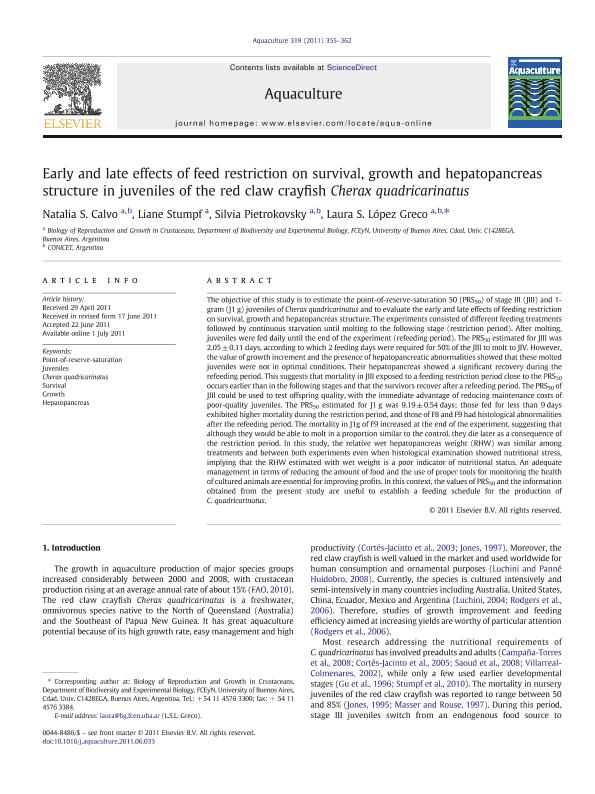Artículo
Early and late effects of feed restriction on survival, growth and hepatopancreas structure in juveniles of the red claw crayfish Cherax quadricarinatus
Fecha de publicación:
10/2011
Editorial:
Elsevier Science
Revista:
Aquaculture
ISSN:
0044-8486
Idioma:
Inglés
Tipo de recurso:
Artículo publicado
Clasificación temática:
Resumen
The objective of this study is to estimate the point-of-reserve-saturation 50 (PRS50) of stage III (JIII) and 1-gram (J1g) juveniles of Cherax quadricarinatus and to evaluate the early and late effects of feeding restriction on survival, growth and hepatopancreas structure. The experiments consisted of different feeding treatments followed by continuous starvation until molting to the following stage (restriction period). After molting, juveniles were fed daily until the end of the experiment (refeeding period). The PRS50 estimated for JIII was 2.05±0.11days, according to which 2 feeding days were required for 50% of the JIII to molt to JIV. However, the value of growth increment and the presence of hepatopancreatic abnormalities showed that these molted juveniles were not in optimal conditions. Their hepatopancreas showed a significant recovery during the refeeding period. This suggests that mortality in JIII exposed to a feeding restriction period close to the PRS50 occurs earlier than in the following stages and that the survivors recover after a refeeding period. The PRS50 of JIII could be used to test offspring quality, with the immediate advantage of reducing maintenance costs of poor-quality juveniles. The PRS50 estimated for J1g was 9.19±0.54days; those fed for less than 9days exhibited higher mortality during the restriction period, and those of F8 and F9 had histological abnormalities after the refeeding period. The mortality in J1g of F9 increased at the end of the experiment, suggesting that although they would be able to molt in a proportion similar to the control, they die later as a consequence of the restriction period. In this study, the relative wet hepatopancreas weight (RHW) was similar among treatments and between both experiments even when histological examination showed nutritional stress, implying that the RHW estimated with wet weight is a poor indicator of nutritional status. An adequate management in terms of reducing the amount of food and the use of proper tools for monitoring the health of cultured animals are essential for improving profits. In this context, the values of PRS50 and the information obtained from the present study are useful to establish a feeding schedule for the production of C. quadricarinatus.
Archivos asociados
Licencia
Identificadores
Colecciones
Articulos(IBBEA)
Articulos de INSTITUTO DE BIODIVERSIDAD Y BIOLOGIA EXPERIMENTAL Y APLICADA
Articulos de INSTITUTO DE BIODIVERSIDAD Y BIOLOGIA EXPERIMENTAL Y APLICADA
Articulos(IEGEBA)
Articulos de INSTITUTO DE ECOLOGIA, GENETICA Y EVOLUCION DE BS. AS
Articulos de INSTITUTO DE ECOLOGIA, GENETICA Y EVOLUCION DE BS. AS
Articulos(OCA CIUDAD UNIVERSITARIA)
Articulos de OFICINA DE COORDINACION ADMINISTRATIVA CIUDAD UNIVERSITARIA
Articulos de OFICINA DE COORDINACION ADMINISTRATIVA CIUDAD UNIVERSITARIA
Citación
Calvo, Natalia Soledad; Stumpf, Liane; Pietrokovsky, Silvia Monica; Lopez, Laura Susana; Early and late effects of feed restriction on survival, growth and hepatopancreas structure in juveniles of the red claw crayfish Cherax quadricarinatus; Elsevier Science; Aquaculture; 319; 3-4; 10-2011; 355-362
Compartir
Altmétricas




